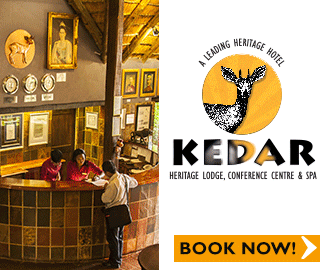
Gorrillas In Our Midst
BY TAFFETA GREY 24TH OCT, 2014 13:35
Only 700 of these magnificent beasts live in the mountainous African jungle, but numbers are recovering and tourists are helping to ensure their survival.
At £300 a person per day, trekking
brings £2 million to uganda and
rwanda, which accounts for around
50 per cent of uganda's wildlife
Authorities' annual income and funds staff training, anti-poaching patrols and the protection of the national parks."
"
There's also a crackling bonfire, around which guests compare their ape encounters to the beat of an African drum. The only down side of seeing gorillas is that you can't help wanting to see them again. And at £300 ago, it's a business. But after our successful trek in Bwindi, we are eager to repeat the experience and headover the border to Rwanda whose gorillas were made famous by the American primatologist Dian Fossey.
On entering Rwanda, there are signs of construction at every turn. Fifteen years on from the 1994 genocide, Rwanda is a nation determined to get back on its feet. The government is pumping money into regeneration and over the next three to four years, existing hotels will be revamped and new sites developed, making Rwanda an enticing prospect for those looking to safari in style. I am staying at Sabyinyo Silverback Lodge, Rwanda's first truly five-star accommodation. It's a unique partnership between Kenya-based safari experts, Governors' Camp, and is run in conjunction with the African Wildlife Foundation to support local conservation initiatives.
Surrounded by the mighty Virunga volcanoes, the lodge has eight stone cottages each with their own wood fire – it gets very cold in the mountains, especially if you've spent a few days in the dry heat of Uganda's savannah. Each cottage has its own sitting room complete with fire places that are kept well-stoked for your return, while the main lodge has big comfy sofas where you can cuddle up with a cup of tea and freshly made cake or gin and tonic after a long day trekking. Our guides are busy on their mobile phones talking to the trackers who left hours ahead of us to locate the apes. We are in luck. Just when I think we have started to walk round in circles, the guide points to fresh tracks in front of us.
Seeing the gorillas a second time is just as exhilarating as the first — perhaps even more so because we had worked so hard to find them. The apes have made a clearing in the nettles. Deliberately ignoring our presence, the adults lay about snoozing or grooming each other as their young play fight and practise their chest beating.
Rwanda's gorillas look larger than their Ugandan counterparts, or maybe they just have thickercoats to protect themagainst the colder weather. Either way, the silverback ofthe group, Kurira, is the mostimpressive beast I've seen —a bigger version of Rwansigozi. Kurira sits holding court,his family scattered in looseclusters in front of him. Three juveniles play noisily.One pretends to be boredmomentarily, feigning interestin the nearby vegetation before pouncing on his unprepared opponent. Kurira, seemingly irritated by their playful mischief, reaches over and slaps the unsuspecting delinquent with his massive hand. A huge thud reverberates in the trees. As Kurira rises onto his fists and strolls past us,his authority is frighteningly obvious.
Thirty eight gorillas stop what theyare doing and follow him up the volcano.We watch breathlessly while gorillas stuff vegetationinto their mouths at impressive speeds.Every so often, above the crunch of perpetual munching, they break wind in a concerto of unconscious obscenity. My time with these great apes is drawing to a close.

The Bwindi Impenetrable Forest certainly lives up to its name. The canopy is a roof of tightly intertwined trees and vines that create layer upon layer of shadow. The early-morning cloud hangs low and uninviting amid the branches. Our guide, Male, promises, however, that the forest can be infiltrated — but it's not going to be easy.
Fifteen minutes into our trek through Uganda's great forest, I lose count of the number of times I have slipped on the muddy ground. So has Male, apparently, who carries on regardless. As he disappears into the deep green, the only thing I can hear is the sound of his machete thrashing through the thick undergrowth and a murmur of excited voices. I pause to catch my breath (the higher altitude makes you feel more unfit than you might otherwise), and, suddenly, through a gap in the trees, I see the unmistakable, magnificent silhouette of a great ape. It's hard to exaggerate the sense of exhilaration you feel laying eyes on a mountain gorilla.
As an animal lover and trained zoologist, I have been dreaming of this moment for a long time. But you don't have to be a nature geek to get the thrill. I understand immediately what David Attenborough meant when he said, 'There is more meaning and mutual understanding in exchanging a glance with a gorilla than with any other animal I know.'I'm in Uganda with the Brightonbased World Primate Safaris. Not only do they offer expert knowledge of primates and the best places to see them, but they support the local communities and work alongside conservation organisations such as The Born Free Foundation.
The goal of our trip is to see gorillas in the wild, not just in Uganda but across the border in Rwanda too.We're staying at the Gorilla Forest Camp,a sumptuous tentedlodge, and one of only two places tostay within the Impenetrable Forest, whichmeans a crucial extra half-hour in bedwith a hot-water bottle before themorning trek. We arrived in Entebbeon Lake Victoria a week ago,travelling west by 4x4, followingthe foothills of the Rwenzorimountains southwards with ouranticipation of seeing thegorillas growing every step of the way.Distances are short comparedto most of East Africa — safarisites are usually between two and fivehours' drive away.
From the 4x4 window,Uganda's landscape was gloriouslyinconstant — mountains slope into plainsof grass and acacia, thick jungle meltsinto eastern savannah. We walked withchimpanzees in Kibale National Forest,watched hippos and crocodiles wallowingin mud on the banks of the KazingaChannel and witnessed lions climbingtrees in Ishasha, Queen Elizabeth National Park.And now I'm in Bwindi, home to oneof the richest ecosystems in Africa, located on the far south western tip of Uganda, literally face to face with a gorilla. And not just one. I feel like I am being watched from every angle — and I am. Our gorilla is part of a 22-strong family group, and the biggest habituated group of gorillas in Bwindi. There are gorillas everywhere. Adults are busy feeding while juveniles slide down tree trunkslike fluffy firemen. And as we creep nearer the centre of the group it is clear which great ape demands the most attention.
In the distance sits a regal silver back, glaring at his visitors with vague contempt. After several minutes, he emanates a mighty huffand turns his muscular back on us, showing off a fine matt of grey hair. Male whispers that this is Rwansigozi, meaning 'strong young man'. Rwansigozi lies back contentedly, his deep-throated murmurs rumbling through the impenetrable forest. Another juvenile somersaults between two snoozing adults, pulling at leaves and grasping at the vines. He bounces up and down, thumping his chest to show us how tough he is. Nearby, a new mother eyes the humans nervously, clasping her youngest to her chest. Her infant glares at us with inquisitive and huorous eyes. The gorillas share their forest with a bewildering diversity of creatures: 120 species of mammals, 346 of birds, 202 of butterflies, 27 of frogs, chameleons and geckos to list just a few. But it is for its gorillas that it is best known and it's depressing to think that the 340 remaining Bwindi gorillas represent half the world's population of this endangered species. Only 720 mountain gorillas are thought to survive in Uganda, Rwanda and the Democratic Republic of the Congo.
Since they were first recorded in the wild in the 1850s, numbers have been threatened by poaching, hunting, disease, habitat destruction, and war. Poaching has died down, though there are still reports of sporadic killings and trap casualties. The survival of this species is in large part due to the ongoing work of park rangers, local communities, and international conservationists and the Ugandan and Rwandan governments. Both countries have invested large sums in conservation projects, and are reaping the rewards of increased tourism. Many of the remaining gorillas have been 'habituated', a process that, in effect, involves someone sitting in their midst for four or five years.
There are four habituated mountain gorilla groups in Uganda and seven in Rwanda, and a maximum of eight tourists are allowed to visit the group each day. We are at full capacity today with a mainly European contingent and we have been assigned the Habinyanja or 'H' group, which has been receiving tourists since 1999.As I crouch in the bushes staring at this magnificent species, it's easy to see why people want to come here. And it's important they do. At £300 per person per day, trekking brings £2 million to Uganda and Rwanda, which accounts for around 50 per cent of Uganda's Wildlife Authorities' annual income and funds staff training, anti-poaching patrols and the protection of the national parks. Strict controls are in place to protect the animals.
No one with a cold or flu is allowed in and we're instructed to keep seven metres from the gorillas at all times (although the gorillas sometimes have different ideas). Including the income from hotels and restaurants, gorilla tourism in this region amounts to £13 million a year. High-end ecolodges are sprouting up to support the growing demand. After the appetite-building experience of watching gorillas chomp their way through mountains of foliage (they have a 50lb-a-day bamboo habit), the Gorilla Forest Camp serves up a four-course dinner back at the camp.














